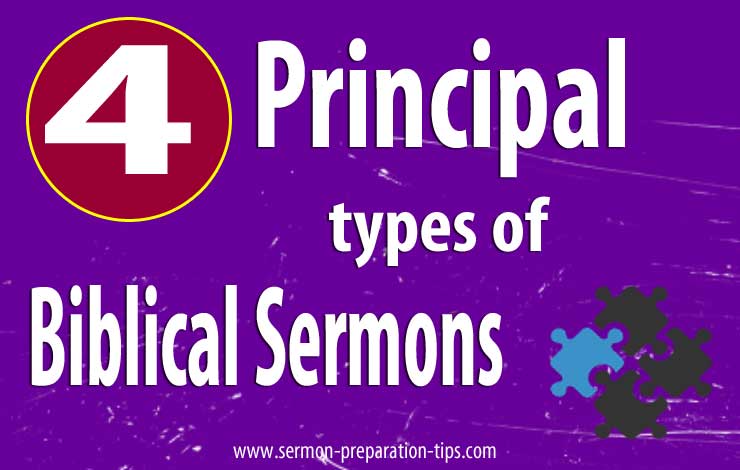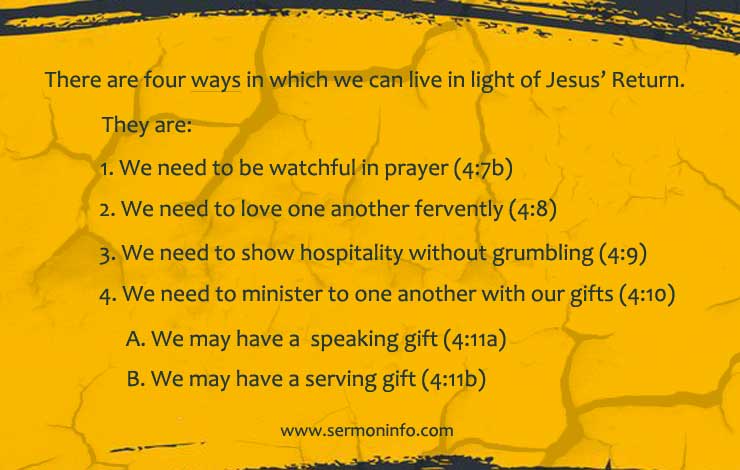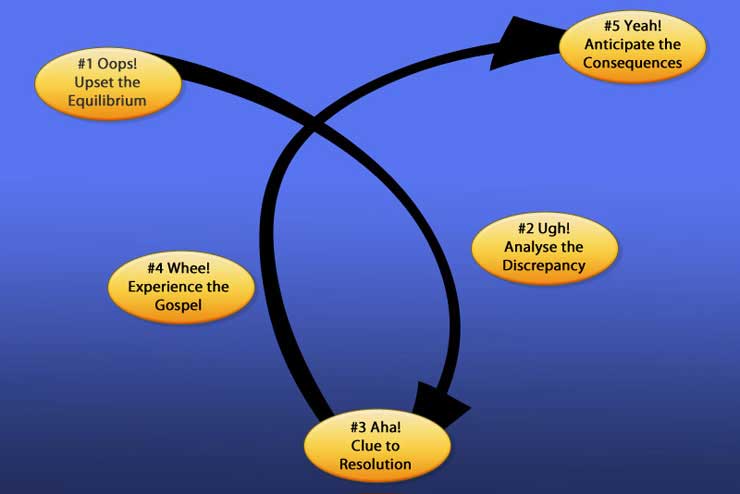4 Principal Types of Biblical Sermons: There are several types of sermons and various way of categorizing them.
I find that the simplest way to categorize the principal types of biblical sermons is to classify them as expository, textual, topical and narrative. I would encourage you to read through the examples below in order to grasp the difference between the 4 principal types of biblical sermons.

4 Principal Types of Biblical Sermons
I will give a brief explanation of each principal type of a biblical sermon followed by a more in-depth explanation of each principal type of biblical sermon.
1. Expository Sermons
Expository sermons are sermons in which an extended portion of Scripture is interpreted in relation to one theme or subject. The bulk of the information for the sermon is drawn directly from the passage and the expository outline consists of a series of progressive ideas focused around the one main idea.
2. Textual Sermons
Textual sermons are sermons in which the main divisions are derived from a verse of Scripture or a small portion of Scripture. The verse of Scripture or the small portion of Scripture provides the theme of the sermon.
3. Topical Sermons
Topical sermons are sermons in which the main divisions are derived from the topic independent of the text of Scripture.
4. Narrative Sermons
Narrative sermons are sermons in which the main divisions are developed from a passage of Scripture which presents loosely associated ideas that narrow down to a single idea in order to deliver an important message. Narrative sermons are generally structured using the inductive method of sermon preparation.

Example of an Expository Sermon
The expository sermon is a sermon in which the main divisions are derived from an extended portion of Scripture in relation to one theme or subject.
In light of the above explanation, the expository sermon outline is structured from the extended portion of Scripture with a main preaching point, sub-points and incidental points. The best way to explain an expository sermon outline is to give an example of an expository outline.
Let’s read 1 Peter 4:7-11 and create an expository sermon outline! (7) “But the end of all things is at hand; therefore be serious and watchful in your prayers. (8) And above all things have fervent love for one another, for love will cover a multitude of sins. (9) Be hospital to one another without grumbling. (10) As each one has received a gift, minister it to one another, as good stewards of the manifold grace of God. (11) If anyone speaks, let him speak as the oracles of God. If anyone ministers, let him do it as with the ability which God supplies, that in all things God may be glorified through Jesus Christ, to whom belong the glory and the dominion forever and ever. Amen.”
The main thrust of 1 Peter 4:7-11 is shown by the underlined words in this portion of Scripture. The expository outline was crafted around these underlined words.
In Peter 4:7-11, the main preaching point is “living in light of Jesus’ return.” There are four ways in which we can live in light of Jesus’ return (4:7a). They are: we need to be watchful in prayer (4:7b); we need to show fervent love toward one another (4:8); we need to show hospitality without grumbling (4:9) and we need to minister to one another with our gifts (4:10). These four ways divide the passage of Scripture into four preaching points. The fourth point is divided into two incidental points. They are: we may have a speaking gift (4:11a) or we may have a serving gift (4:11b).
Here is an example of an expository sermon outline!
Introduction:
There are four ways in which we can live in light of Jesus’ return. They are:
- We need to be watchful in prayer (4:7b)
- We need to show fervent love to one another (4:8)
- We need to show hospitality without grumbling (4:9)
- We need to minister to one another with our gifts (4:10)
- We may have a speaking gift (4:11a)
- We may have a serving gift (4:11b)
Conclusion:
Once the expository outline is completed, you simply need to write content to the outline with illustrations and applications. Then you will need to write the introduction and the conclusion.
Example of a Textual Sermon:
A textual sermon is similar to an expository sermon; however, the textual sermon derives its main divisions from a single verse or two of Scripture or sometimes a part of a verse of Scripture in relation to one theme or subject.
A textual sermon is structure from the verse of Scripture with a main preaching point, sub-points and incidental point.
Again the best way to explain a textual sermon is to give an example of a textual sermon outline from a verse of Scripture.
Let’s read 2 Timothy 3:16-17 and create a textual sermon outline. (16) “All Scripture is given by inspiration of God, and is profitable for doctrine, for reproof, for correction, for instruction in righteousness, (17) that the man of God may be complete, thoroughly equipped for every good work.”
The main parts of these two verses are shown by the underlined words. These two verses are talking about God’s word and how it can benefit the Christian in his or her walk with God.
I crafted the main preaching point around the topic: “Embracing the Power of God’s word.” I develop three sub-points from these two verses. They are: God’s word is inspired (3:16a), God’s word is profitable (3:16b) and God’s word is dependable (3:17). I developed two incidental points under each sub-point in order to expand and explain each sub-point.
Here is an example of a textual sermon outline from 2 Timothy 3:16-17!
Introduction:
There are three reasons why we need to embrace the power of God’s word. They are:
- God’s word is inspired (3:16a)
- It pierces the heart (Acts 2:37)
- It reveals the heart (Hebrews 4:12)
- God’s word is profitable (3:16b)
- It establishes a right belief
- It establishes a right behaviour
- God’s word is dependable (3:17)
- It brings you to maturity (3:17a)
- It equips you for ministry (3:17b)
Conclusion:
Again, once you have completed the textual sermon outline, you will need to add content to the outline with illustrations and applications. Once you finish that, you will need to write the introduction and the conclusion.
Example of a Topical Sermon:
A topical sermon is a sermon in which the main divisions are derived from the topic independent of the text of Scripture.
A topical sermon still needs structure in order to package the information for delivery to the audience. The topical sermon outline will need a main preaching point with sub-points and incidental points.
The best way to explain a topical sermon is to give an example of a topical sermon outline.
I develop a topical sermon outline with the main preaching point being: “How to share God’s love with others?” I crafted four sub-points in order to expand and explain the different ways we can share God’s love with others.
Here is an example of a topical sermon outline from different passages of Scripture!
Introduction:
There are four ways we can share God’s love with others. They involve:
- Tender Love (Ephesians 4:32)
- Tender love is a battle sometimes
- Tender love is doing what Jesus did
- Tough Love (Matthew 23:23ff)
- Tough love is a battle sometimes
- Tough love is being firm but sensitive
- Sacrificial Love (1 John 3:16)
- Sacrificial love costs
- Sacrificial love is about giving of self
- Radical Love (Matthew 5:39-41)
- Radical love does not retaliate
- Radical love goes beyond legal rights
- Radical love goes the second mile
Conclusion:
Once you finish crafting the topical sermon outline, you will need to write content to the topical sermon outline with illustrations and applications. You will also need to write an introduction and conclusion.
Example of a Narrative Sermon:
A narrative sermon takes the audience on a journey by delivering loosely associated points which narrow down to a single point in order to deliver an important message.
Though the narrative sermon is a journey on which you take your audience; nevertheless, you still need a narrative sermon outline to package the biblical information in order to deliver the important message to the audience.
I will use Lowry’s Loop as an example of a narrative sermon outline.
Lowry has explained this model in his book: “The Homiletical Plot: The Sermon as Narrative Art Form” (Check it out at Amazon Books). Lowry’s Loop model has five stages.
1. OOPS – Upsetting the Equilibrium
The OOPS stage provides tension as a form of introduction to the message which you want to convey to the audience.
The tension should create interest to engage the audience and create a need to resolve the issues at hand.
2. UGH – Analyzing the Discrepancy
The UGH stage is where you analyze the tension so that you can create movement toward the resolution.
3. AHA – Disclosing the Clue to Resolution
The AHA stage is where you build the bridge between tension and resolution.
This is where you skilfully take the audience to the resolution by shining a different light on the situation.
4. WHEE – Experiencing the Gospel
The WHEE stage involves the God factor in the whole experience.
5. YEAH – Anticipating the Consequences
The YEAH stage is where you deal with the reaction of the audience in relation to the WHEE stage. If God has done this great thing, how should we react?

Here is an example of a narrative sermon outline from 2 Peter 1:1-4 using Lowry’s Loop model!
- The world is falling apart (OOPS)
- And the church is crumbling around us (UGH)
- But we are able to turn it around – spiritual growth (AHA)
- Spiritual growth is God’s key to turning it around (WHEE)
- It begins with the path of faith (1:1)
- It continues with the provision of power (1:3)
- It is maintained with the promise of enablement (1:4)
- Let’s grow spiritually and make a difference in the church and in the world (YEAH)
Once you have crafted the narrative sermon outline, you will need to add content to the sermon outline with illustrations and application.
Summary Comments
The 4 principal types of biblical sermons are best categorized by classifying them as expository, textual, topical and narrative. For more information on these 4 principal types of biblical sermons, you will need to check out the resource books below.
Resources for 4 Principal Types of Bible Sermons
How To Prepare Bible Messages by James Braga (Check it out at Amazon Books)
The Homiletical Plot: The Sermon as Narrative Art Form by Eugene Lowry (Check it out at Amazon Books)